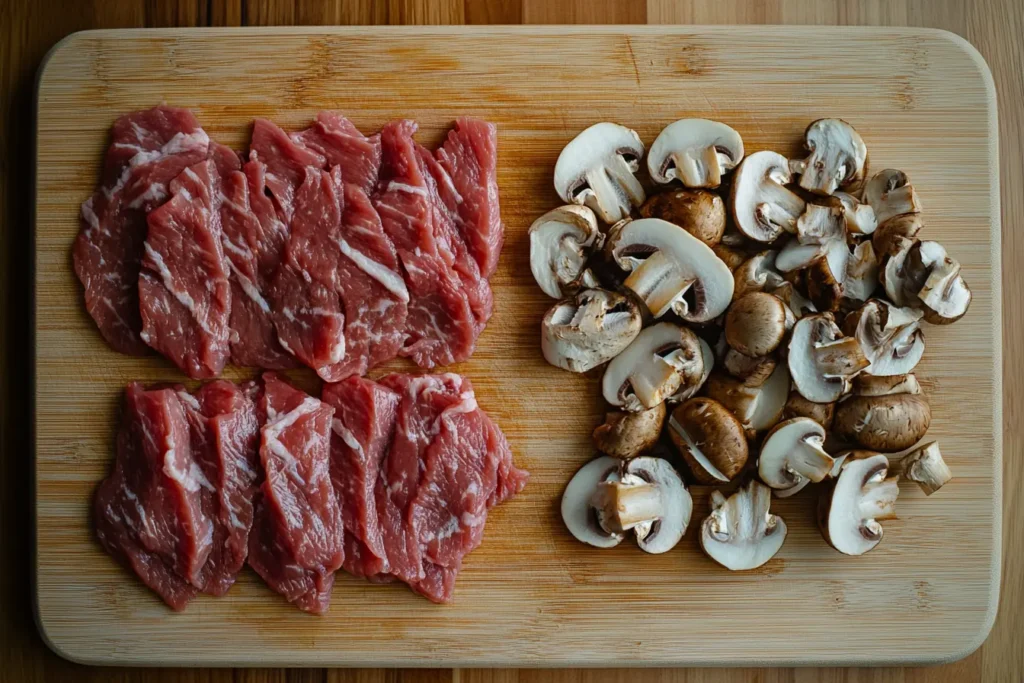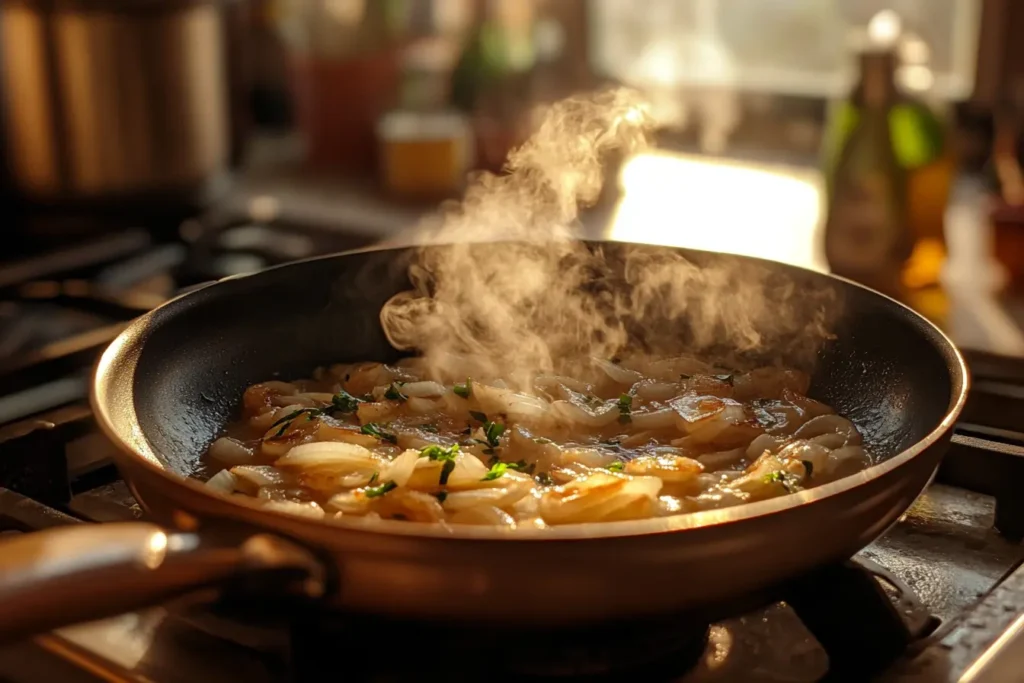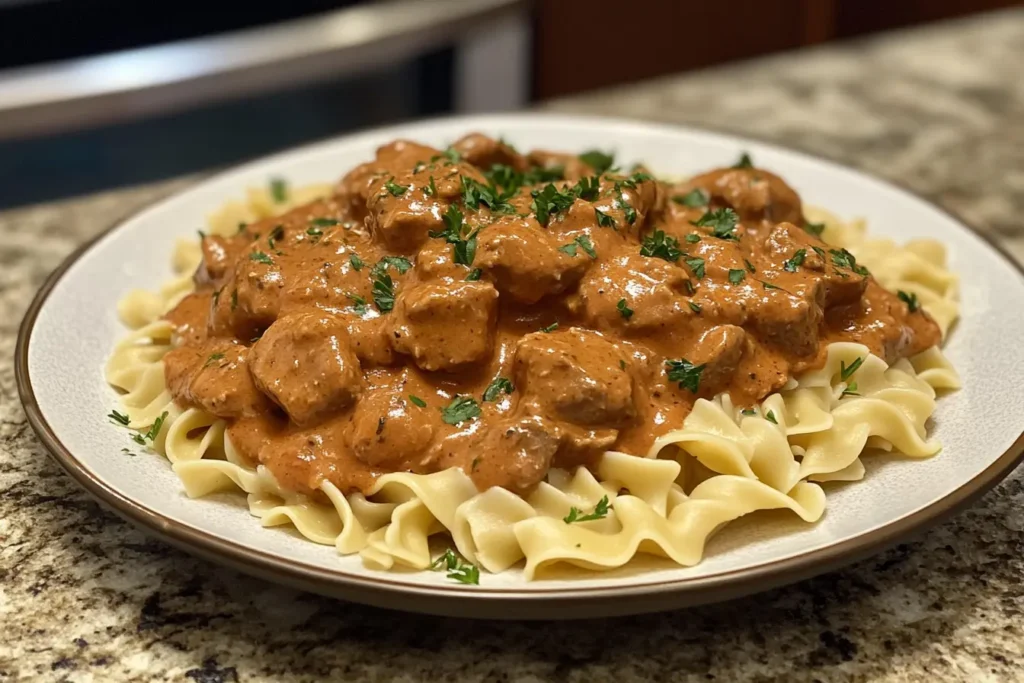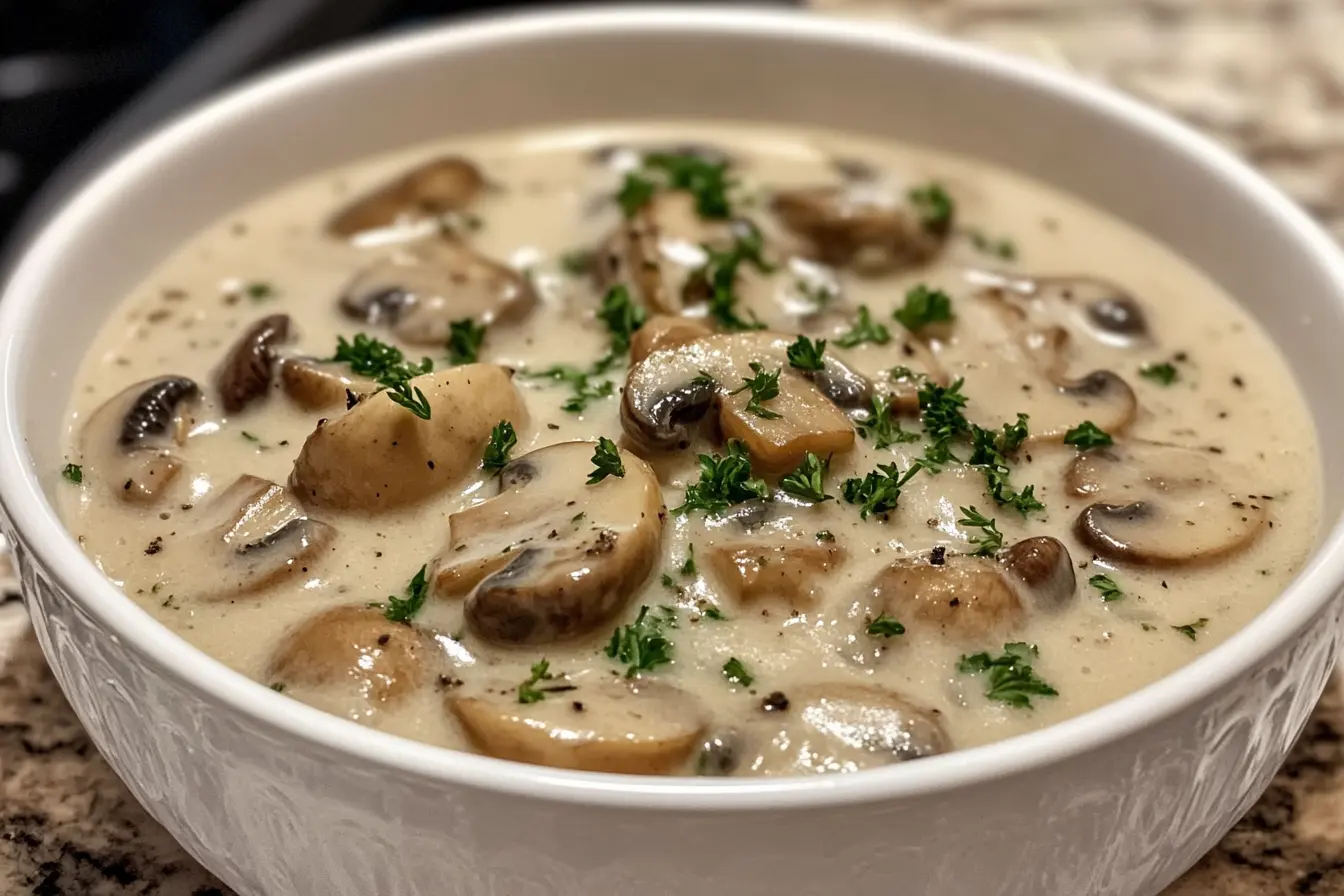Introduction
Crafted deep within the heart of Russian cuisine, beef stroganoff sauce enchants the senses witArticle’s Intro:
Beef stroganoff sauce emerged long ago, born from Russian cuisine and cherished for its creamy depth, savory aroma, and comforting warmth. Although it has crisscrossed borders and inspired countless versions, its rich core still fascinates cooks and diners. We plan to show what the sauce in beef stroganoff is made of and how it grew from a simple mixture into a versatile dish that adapts to many tastes. Moreover, we will trace its origins, highlight its cultural significance, and reveal the classic elements that give it its special charm. Let’s begin this flavor-filled journey with a look at the past and its enduring appeal. After all, this dish offers more than a random blend of sour cream and mushrooms—it presents a timeless classic that continues to delight.
What Is the Sauce in Beef Stroganoff Made Of?
We ask ourselves: “What is the sauce in beef stroganoff made of?” Rather than a plain gravy, it thrives as a creamy mix that balances tangy dairy with hearty broth, tender mushrooms, and sweet onions. Many cooks add a small amount of thickener, often flour, to give it body. Across the globe, culinary enthusiasts tweak each layer, experimenting and adjusting. This allows the sauce to shine as a timeless favorite.
Origin and History of This Russian Culinary Tradition
The roots of beef stroganoff sauce stretch back to 19th-century Russia, where families with means enjoyed lavish dinners. They embraced a dish that mingled simple, local ingredients with new tastes. Over time, cooks shared this savory treat, helping it spread far beyond its homeland. The main sauce, brimming with mushroom cream sauce goodness, always played a starring role. For more insight into such long-standing cooking practices, browse through Russian culinary traditions and discover how layers of cultural exchange helped shape dishes like this.
Traditional vs. Modern Interpretations of the Creamy Beef Dish
Originally, cooks kept beef stroganoff sauce simple, leaning on basic flavorings and a dollop of tangy dairy. In contrast, today’s chefs often introduce new spices or fresh herbs to highlight depth. Some prefer lighter options, using leaner cuts and gentle seasoning. Others double down on savory notes, adding extra mushrooms or a richer broth. Such variety ensures that both old-school admirers and fresh explorers find reasons to love this umami flavors-packed classic.
Defining the Creamy Beef Stroganoff Sauce Base
This velvety Stroganoff sauce relies on a careful balance. You blend savory broth with tangy dairy and meaty mushrooms, then add a gentle thickener. It draws its richness from simple elements that work together in harmony. By selecting quality ingredients and following an easy method, you can create a mushroom cream sauce that dazzles the palate. These steps ensure a reliable process for every home cook, no matter their skill level.
Essential Ingredients List (Easy-to-Find Items)

- Lean Beef Strips: Choose tender cuts trimmed of excess fat.
- Fresh Mushrooms (Button or Cremini): Slice them to deliver that deep, earthy taste.
- Onion (Finely Chopped): Adds mild sweetness and body.
- Garlic (Minced): Boosts aroma and depth.
- Low-Sodium Beef Broth: Contributes savory essence without overwhelming saltiness.
- Sour Cream (or Plain Greek Yogurt): Brings creamy texture and tangy flavor.
- Mild Oil (e.g., Sunflower Oil): Aids in sautéing and prevents sticking.
- Butter: Enhances richness and smoothness.
- Flour or Cornstarch (as Thickener): Ensures the sauce stays silky, not runny.
- Salt and Pepper (to taste): Adjust according to personal preference.
- Paprika (Optional): Lends subtle warmth and color.
- Fresh Parsley (Chopped, Optional): Adds brightness as a garnish.
(For safe handling and quality checks, consider reviewing safe food handling practices to maintain freshness and good hygiene.)

Step-by-Step Cooking Instructions
Step1: Prep all ingredients. Pat the beef dry, slice it into thin strips, chop the onion, mince the garlic, and slice the mushrooms. Keep them close at hand.
Step2: Warm oil in a large skillet over medium heat. Add the beef strips in small batches. Cook until they turn lightly browned. Transfer them to a plate.
Step3: Melt a bit of butter in the same pan. Add the onion and cook until it turns translucent. Toss in the garlic and stir for a few seconds.
Step4: Add the mushrooms and cook them until they release moisture and turn soft. Sprinkle in a small amount of flour or cornstarch. Stir well so it blends without lumps.
Step5: Pour in the beef broth slowly. Stir to incorporate the thickener. Let it simmer until the mixture thickens and the flavors meld.
Step6: Reduce the heat. Stir in the sour cream or yogurt. Make sure the sauce warms gently, never boiling, to avoid curdling. Taste and adjust seasonings with salt, pepper, or paprika.
Step7: Return the beef strips to the pan. Stir until coated with the sauce. Let the mixture simmer for a brief moment so the flavors unite.
Step8: Sprinkle fresh parsley on top if you wish. Serve hot over noodles, rice, or potatoes.
(Keep sentences short and instructions direct. This approach makes it easy to follow the recipe without confusion.)
Nutritional Content (Per 100g)
Below you will find an approximate nutritional breakdown for beef stroganoff sauce with lean beef and sour cream. The values may vary based on specific brands and ingredient types.
| Nutrient | Amount per 100g |
|---|---|
| Energy (kcal) | ~150 |
| Protein (g) | ~10 |
| Fat (g) | ~7 |
| Carbohydrates (g) | ~6 |
| Fiber (g) | ~1 |
| Sodium (mg) | ~250 |
Techniques and Variations in Making Creamy Beef Stroganoff Sauce
(In the next subsection), we will explore the cooking methods and possible twists that bring this velvety Stroganoff sauce to life. Each approach helps shape the final dish into something that matches your preference, whether you crave a thicker sauce, a lighter texture, or a dairy-free option. Keep these tips handy, adjust them as needed, and enjoy the process.
Step-by-Step Sauce Preparation Techniques
To perfect the beef stroganoff sauce, start by preparing each element with care. First, brown the beef strips in small batches to develop rich layers. Set them aside while you sauté the onions until they turn soft and sweet. Next, add mushrooms and cook until their moisture evaporates. Sprinkle in a small amount of flour or cornstarch, then stir to form a smooth base. Pour in broth, stirring often, and watch as the mixture thickens. Finally, reduce the heat, fold in the sour cream, and return the beef to the pan. Taste and adjust seasoning. These steps let each ingredient shine, producing a sauce that balances creaminess, savory depth, and gentle tang.
(In the succeeding section), remember that adjustments can make the sauce suit your exact taste.
Adjusting Consistency and Flavor
Sometimes the sauce turns out too thick. If that happens, add a splash of broth. Stir until the texture loosens. If the sauce seems too thin, mix a small spoon of cornstarch with cold water and stir it in slowly. Taste after each adjustment, then add more seasoning as needed. A pinch of salt or a dash of paprika can brighten the flavors. Adjust step by step, rather than all at once. This careful tweaking lets you find the perfect balance.
(Advancing to the next topic), we will consider those who need dietary changes.
Dietary Considerations
If you can’t have dairy, try using a plant-based cream. For example, unsweetened cashew cream offers a creamy mouthfeel without dairy. If you want to reduce fat, pick lean beef and use low-fat yogurt. Adjust seasonings to keep the flavor vibrant. Also, consider visiting dairy-free recipe adaptations for more ideas on replacing dairy while maintaining taste. These small changes ensure everyone can enjoy this mushroom cream sauce.
(On to the following discussion), we’ll see how regional choices shape this recipe.
Regional Twists and Modern Takes
In some regions, cooks prefer more mushrooms for extra umami. Others might add mild spices for subtle warmth. Certain families rely on yogurt instead of sour cream. Many home cooks experiment with fresh herbs like parsley or dill. They find balance by blending local elements, which create a unique signature. By exploring these choices, you gain new ways to enjoy beef stroganoff sauce. Try different mushrooms or consider a pinch of mild seasoning. Each tweak can shift the flavor and texture to suit your mood.
(Heading into the subsequent area), let’s think about serving ideas.
Serving Suggestions
Serve beef stroganoff sauce over wide noodles, rice, or smooth mashed potatoes. Add a handful of chopped parsley on top for a pop of green. Pair it with a light side salad or roasted vegetables to create a pleasing meal. Adjust your sides based on personal taste. This sauce’s creamy and savory nature pairs well with simple, mild accompaniments.
(Continuing in the following part), we’ll discuss common mistakes, storage tips, and professional hints that elevate the dish.

Common Mistakes, Storage, and Expert Tips
(Moving forward to the next topic), let’s explore the pitfalls some cooks face when making this creamy Stroganoff sauce. We will also discuss how to store it to keep its taste fresh. Finally, we’ll highlight expert suggestions that help you craft an extraordinary dish every time.
Common Mistakes in Making the Mushroom Cream Sauce
One frequent error occurs when cooks rush and overcrowd the pan. This prevents proper browning and reduces flavor depth. Another issue happens if the sauce thickens too much, causing a pasty texture. Some add the tangy cream too soon at a high heat, which may lead to curdling. Also, if you skip seasoning or use poor-quality broth, the sauce can turn bland. With patience, quality ingredients, and mindful timing, you avoid these common mishaps.
(In the ensuing segment), let’s address how to prevent that dreaded curdling effect.
How to Prevent Sauce Curdling
To keep your beef stroganoff sauce smooth, lower the heat before you add the sour cream or yogurt. Blend it in slowly and stir gently. Avoid boiling the mixture once dairy enters. If you see small lumps, remove the pan from heat and stir until the sauce becomes creamy again. A careful approach helps you maintain a velvety consistency.
(Heading into the subsequent area), we’ll consider how to store and reheat your sauce.
Storage and Reheating Tips
Always store leftover sauce in a sealed container inside the refrigerator. Use it within two or three days for the best taste. When reheating, warm it slowly over low to medium heat. Stir while it warms to restore its silky texture. Avoid excessive heat, which might cause separation. For guidance on proper handling and storage practices, remember to follow food safety guidelines. Keep these tips in mind, and your sauce will taste fresh even the next day.
(Advancing to the following area), let’s embrace some expert suggestions.
Expert Tips for an Authentic Stroganoff Sauce
Skilled cooks emphasize using fresh mushrooms for more umami flavors. Many prefer cutting the beef into uniform strips for even cooking. Some suggest adding a gentle sprinkle of paprika or fresh herbs to refine the dish’s complexity. Others recommend tasting as you go. Adjust salt, pepper, or other seasoning in small increments. These small steps create a more controlled and enjoyable cooking process, helping you produce a sauce that stands out from the ordinary.
FAQs, Additional Resources
(Transitioning into the following chapter), let’s address common questions people ask about beef stroganoff sauce, its key components, and similar culinary concerns. These answers aim to clear confusion, guide home cooks, and inspire tasty variations. After exploring these FAQs, you may feel more confident when preparing this comforting dish or experimenting with related techniques.
Frequently Asked Questions
Q1: What cut of meat is best for beef stroganoff?
Choose a tender cut like sirloin or tenderloin. These cuts cook quickly and remain juicy without becoming tough. Slice them thinly and against the grain to keep them tender.
Q2: Can I use yogurt instead of sour cream in stroganoff?
Yes, plain Greek yogurt makes a great substitute. It provides tang and creaminess while reducing fat. Add it after you lower the heat to avoid curdling.
Q3: Why is my beef stroganoff chewy?
Chewy beef often results from overcooking or using a tough cut. To fix this, choose quality meat and cook it briefly. Also, slice it thinly so it cooks evenly. Avoid simmering the beef too long.
Q4: How to make chicken pieces tender?
Marinate chicken in a mild, acidic mixture like yogurt or a squeeze of lemon for a short time. Cut the pieces evenly, cook them at moderate heat, and don’t overcook. Tender chicken relies on careful timing and gentle heat.
Q5: How to mash raw chicken?
It’s best to avoid mashing raw chicken by hand. Instead, use a food processor with a few quick pulses to achieve a ground texture. Handle raw chicken safely, wash your hands, and sanitize surfaces to prevent contamination.
Q6: How to cook chicken like a chef?
Start with fresh, uniform pieces. Season them simply, then cook in a hot pan with a bit of oil. Aim for a golden-brown sear on the outside and moist meat inside. Taste as you go, adjust seasonings, and let the chicken rest briefly before serving.
(In the next subsection), let’s suggest a few resources that deepen your knowledge or offer helpful cooking tips.
Additional Resources
For more guidance on global recipes and evolving culinary traditions, explore Russian culinary traditions. If you want advice on maintaining a safe kitchen environment, check safe food handling practices. For those who seek dairy-free concepts, look into dairy-free recipe adaptations. These sources help you broaden your horizons and sharpen your cooking skills.
(Moving forward to the conclusion), we will wrap up our discussion and highlight key points that define this classic dish.
Conclusion
Beef stroganoff sauce thrives as a savory blend of tender meat, creamy tang, and subtle seasonings. Its versatility lies in its ability to adapt to personal taste, dietary needs, and regional flair. By choosing quality ingredients, seasoning thoughtfully, and mastering a few simple techniques, you create a comforting meal that honors its Russian cuisine roots while satisfying modern palates. With each spoonful, you enjoy a timeless favorite that continues to delight eaters around the world.

